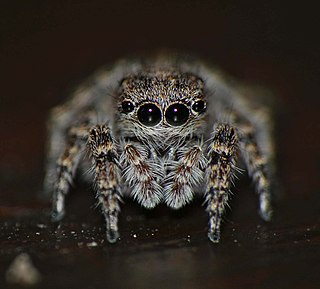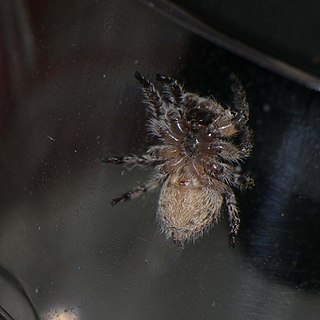
Evarcha is a genus of spiders in the family Salticidae with 85 species distributed across the world.

Phlegra is a genus of jumping spiders that was first described by Eugène Louis Simon in 1876. The name is a reference to a mythical location in both Greek and Roman mythology.
Nigorella hirsuta is a species of jumping spider in the genus Nigorella that lives in South Africa and Zimbabwe. It was first describedin 2009 by Wanda Wesołowska. The spider is medium-sized, with a carapace that is between 3.5 and 4.7 mm long and an abdomen that is between 3.2 and 6.6 mm long. The female is larger than the male. The carapace is generally dark brown and hairy. While the male abdomen is similarly hairy and dark brown, the female abdomen is more grey. The species has been confused with the related Nigorella plebeja. However, it can be generally identified by the strongly sclerotized cups in the female epigyne and the male's longer embolus.
Evarcha flagellaris is a jumping spider species in the genus Evarcha. It lives in Kenya and South Africa. The species was first described in 2011.
Microbianor globosus is a jumping spider species of the genus Microbianor that lives in South Africa. The male was first described in 2011.
Evarcha mirabilis is a jumping spider species in the genus Evarcha that was first identified in South Africa.
Afraflacilla venustula is a jumping spider species in the genus Afraflacilla that lives in South Africa. It is related to Afraflacilla altera.

Evarcha striolata is a species of jumping spider that lives in South Africa. The male was first described in 2009 and the female in 2013.
Pignus pongola is a jumping spider species in the genus Pignus that lives in South Africa. The male was first described in 2009.

Langelurillus namibicus is a species of jumping spider in the genus Langelurillus that lives in Namibia and South Africa. The female was first described in 2011 by Wanda Wesołowska. The male has not been identified. The spider is small, with an abdomen that is typically 2.7 mm (0.11 in) long and a cephalothorax 2.7 mm (0.11 in) long. It is similar to other related species, particularly Langelurillus cedarbergensis, but can be distinguished by its closely-spaced copulatory openings and three-chambered receptacles.

Langelurillus cedarbergensis is a species of jumping spider in the genus Langelurillus that lives in South Africa. It was first described in 2013 by Charles Haddad and Wanda Wesołowska. Only the female has been found. The spider lives in fynbos around the Cederberg Mountains, after which the species is named. It is a small spider, with a cephalothorax between 2.6 and 2.7 mm long and an abdomen between 3.4 and 3.8 mm long. It is similar to other related species, particularly Langelurillus namibicus, but can be distinguished by its widely-spaced copulatory openings and short seminal ducts.

Langelurillus krugeri is a species of jumping spider in the genus Langelurillus that lives in South Africa. The species was first described in 2013 by Wanda Wesołowska and Charles Haddad. The spider is small with a brownish-grey abdomen typically 2.9 mm (0.11 in) long and a black carapace typically 1.9 mm (0.075 in) long. The species is named after Paul Kruger, who had been State President of the South African Republic. The first example was found in the Kruger National Park. The female can be distinguished from other spiders in the genus, particularly Langelurillus primus', in the design of its copulatory organs. The male has not been described.
Thyenula fidelis is a jumping spider species in the genus Thyenula that lives in South Africa.
Massagris natalensis is a jumping spider species in the genus Massagris that lives in South Africa. It was first identified in 2009.
Phlegra karoo is a jumping spider species in the genus Phlegra. It was first identified by Wanda Wesołowska in 2006 and lives in Namibia, South Africa and Zimbabwe.
Phlegra tenella is a jumping spider species in the genus Phlegra that lives in Namibia. The male was first described by Wanda Wesołowska in 2006, but the female has yet to be identified.
Phlegra pusilla is a species of jumping spider in the genus Phlegra. The male was first described in 1994 from a sample from Yemen. The female was subsequently described in 2006, and the distribution of the species identified from across Africa from Senegal to Zimbabwe and into the Arabian Peninsula. The species is identified by a characteristic pattern on the carapace and the structure of the copulatory organs.
Phlegra langanoensis is a jumping spider species in the genus Phlegra that lives in Ethiopia and Zimbabwe. The male was first described in 2008.
Phlegra arborea is a jumping spider species in the genus Phlegra that lives in South Africa. The male was first described in 2009.

Langelurillus squamiger is a species of jumping spider in the genus Langelurillus that lives in South Africa. The species was first described in 2018 by Wanda Wesołowska and Charles Haddad. It is small, the male being slightly smaller than the female, with a cephalothorax that is between 1.9 and 2.4 mm long and an abdomen between 1.5 and 2.4 mm long. It is generally dark brown, with an orange pattern on the abdomen. It is very similar to other spiders in the genus, but differs in the shape of the male's tibial apophysis and the way that the female has both lobes at the back of the epigyne and short seminal ducts. The spider lives in leaves and eats Odontotermes termites alongside Stenaelurillus guttiger and Stenaelurillus modestus.





